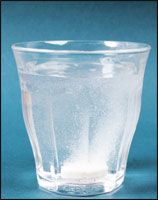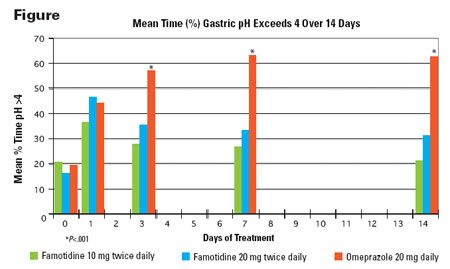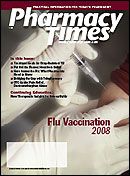Publication
Article
Pharmacy Times
Helping Patients Manage Their Heartburn
Author(s):
Pharmacists are likely to encounter many patients looking for relief from heartburn; a review of 3 classes of OTC medications to treat this common complaint, along with useful counseling tips, is presented here.
Ms. Wick is a senior clinical research pharmacist at the National Cancer Institute, National Institutes of Health, Bethesda, Maryland. The views expressed are those of the author and not those of any government agency.
Pharmacists are likely to seemany heartburn patients. InWestern populations, and theUnited States in particular, up to40% of individuals experience heartburn'smid-chest discomfort, movingup to the throat and neck, or substernalburning,1 with approximately5% experiencing frequent symptoms.2Heartburn can be relatively benign orbecome a frequent problem (occurring.2 days per week) that can havegreat impact on the patient's qualityof life. Myths and presuppositionsabout heartburn relief are abundantand persistent because, in the past,research validating what to recommendas the most appropriate anddurable relief in OTC settings hasbeen nonexistent.3
A Look at OTC Options

Most patients know what causes theirheartburn. Citrus juices, bread, coffee,cucumber, and rich and spicy mealsare common triggers. Overindulgence infood and alcohol (especially right beforebed), smoking, excess weight, and stressare other common causes. When garden-varietyheartburn is the problem, thegoal is to relieve symptoms and restorequality of life; reduce risk of more seriousdisease states; and introduce short- andlong-term acid suppression using anOTC acid-suppressing agent.4,5 Creatinga gastric pH >4 using 1 of 3 classes ofOTC drugs—antacids and alginates, histamineH2-receptor antagonists (H2RAs),or proton pump inhibitors (PPIs)—canbe an effective strategy.6,7
Antacids and Alginates
Many patients with heartburn self-medicatewith OTC antacids and alginates,scheduling a visit with a physician onlyif symptoms escalate or persist. Initially,they may appreciate antacids' rapid butrelatively short-term symptom relief.Viscous alginates, generally providedin combination with an antacid, createa protective barrier on top of gastriccontents, preventing acid contact withthe esophagus.
Although OTC antacids and alginatesmay be useful in mild heartburn,8 onesmall study showed that only around25% of patients report OTC antacidsprovide acceptable symptom relief.9The few controlled studies available todate indicate that OTC antacids' andalginates' strong point is prevention andtreatment of postprandial symptomaticrelief. This defines their niche as appropriatefor occasional meal-induced episodesor for breakthrough symptoms inpatients using longer-acting treatmentslike H2RAs or PPIs.
Histamine H2-Receptor Antagonists
H2RAs competitively and reversiblyblock parietal cell H2-receptors, thusinhibiting acid secretion.10 They can beused to self-medicate during a heartburnepisode, or for prophylaxis beforeconsumption of food or drink knownto trigger reflux symptoms. AlthoughH2RAs have a slower onset of actionthan the antacids, they generally suppressgastric acid for up to 12 hours.3Usually given twice daily, H2RAs suppressapproximately 70% of acid over 24hours.11 Pharmacologic tolerance candevelop with as few as 3 days of dailyuse,6 and with chronic use, the antisecretoryeffect may diminish, leadingto less than satisfactory control.12-16
Proton Pump Inhibitors
PPIs directly and irreversibly block thefinal common pathway for acid secretionin the stomach, the gastric acidpump (H+,K+-ATPase), making themthe drugs of choice for gastric acidsuppression.7 PPIs' once-daily dosingimproves patients' ability to adhere totreatment, especially when comparedwith frequent antacid dosing.17 A recentstudy (Miner et al) has quantified theacid suppression of omeprazole, a PPI,versus famotidine, an H2RA, in an OTCsetting.6 The results establish that, contraryto popular belief, omeprazole'sability to suppress acid on day 1 of a14-day course of treatment is comparableto famotidine's, and better in daysfollowing. Although this study did notmeasure the onset of action or symptomrelief, PPIs' and H2RAs' clinical effectivenessis directly related to gastricacid suppression above a pH of 4.
Day 1 Relief: Antacid, H2RA, or PPI?
Most patients who experience heartburnwant day 1, if not immediate,relief. In fact, even patients who havemore serious reflux disease look forand often prefer on-demand relief.18Although alginates or antacids will provideprompt relief, patients often wanta more enduring relief and look to anOTC H2RA or PPI. Using an OTC H2RAor PPI can bring a period of heartburnunder control; this may decrease thetoal amount of medication taken andthe cost.18 Researchers have believedthat H2RAs surpass PPIs in terms of acidsuppression in the first 24 hours, basedon findings using prescription-strengthdrugs. An OTC PPI can suppress acidsignificantly on day 1, however, comparedwith baseline and comparably to aregular (10 mg) and maximum strength(20 mg) OTC H2RA. Acid suppression instudy participants taking the lower-doseH2RA decreased significantly beginningday 3 (Figure).6

Guidelines for Therapy
Until recently, clinicians generally recommendedH2RAs rather than PPIs for ondemandtherapy because they surmisedthat they would produce faster acid suppressionon day 1 of treatment.19 Existingguidelines for the treatment of heartburnin primary care consider cost-effectivenessof therapy and can guide pharmaciststoward providing the best care.
The American College of Gastroenterology'sevidence-based guidelines recommendpatient-directed lifestyle changesand OTC antacids or acid suppressantsfor patients presenting mild heartburnsymptoms.20 The general approach—one that is sometimes mandated byinsurers—is to start with an antacid foroccasional or brief heartburn episodes,using H2RA for more frequent or persistentsymptoms, and reserving the PPI(due to its perceived slower onset ofanti-secretory activity) for patients withmore frequent heartburn or patients whohave failed other OTC therapy, in a step-upapproach.4,19,20
A study of 593 people reporting heartburncompared step-up therapy and step-downtherapy (use of a PPI followed byan H2RA) with lansoprazole alone fromthe start. Researchers concluded thattreatment with a PPI provides more consistentheartburn relief than an H2RA, orstep-up or step-down therapy.21 A recentsurvey of approximately 1000 primarycare physicians (PCPs) found that thestep-up approach has been largely abandoned;instead, PCPs tend to use a step-inapproach. In the step-in approach,PCPs start therapy with a PPI.22
The Reflux Mnemonic ALARMS:
Anemia
Loss of weight
Anorexia or early satiety
Recurrent symptoms
Mass/melaena (dark stools)
Swallowing difficulties
Further study is needed to verifywhether reserving the PPI until H2RAfailure is necessary; OTC PPIs appearto suppress acid comparably to OTCH2RAs in the first 24 hours, providing amore consistent sustained effect withoutdeveloping tolerance. Experts indicatethat the recent decrease in cost, establishedsafety, and wide availability ofPPIs make them preferable for monotherapyfor the empiric treatment oftypical heartburn symptoms.4
Counseling Considerations
Pharmacists should ask open-endedquestions about concurrent medicationsand supplements, such as NSAIDs, aspirin,glucosamine, and others, that maylist heartburn among their side effects.Sometimes pointed questions about lifestylecan help patients select appropriatelifestyle modifications. Pharmacistsshould remember that for gastrointestinalreflux, certain symptoms shouldraise an alarm (Box). If patients reportany symptom indicative of one of these,referral to a physician is warranted.
Refer patients to their doctor if they:
- have been self-treating unsuccessfullycontinuously for ≥4 weeks
- are ≥45 years old with new or recentlychanged indigestion symptoms
- have unintended weight loss in associationwith indigestion
Conclusion
In the last several years, OTC treatmentoptions for heartburn have expanded.These options vary in cost, dosing convenience,and ability to suppress acid.Pharmacists can recommend OTC productsfor heartburn with confidencethat patients can be satisfied with therelief that follows. Patients with periodicheartburn may find antacids andalginates convenient, inexpensive, andeffective. H2RAs will continue to havea role for patients who need a briefintervention that lasts longer than thatoffered by antacids. Consumers with frequentheartburn (≥2 days per week) maydevelop tolerance to an H2RA rapidlywith daily use; an OTC PPI may providemore durable protection.
References
- Spechler SJ. Epidemiology and natural history of gastrooesophageal reflux disease. Digestion. 1992;51(suppl 1):24-29.
- Heading RC. Epidemiology of oesophageal reflux disease. Scand J Gastroenterol. 1989;168(suppl):33-37.
- Tran T, Lowry AM, El-Serag HB. Meta-analysis: the efficacy of over-the-counter gastro-oesophageal reflux disease therapies. Aliment Pharmacol Ther. 2007;25:143-153.
- Castell DO, Brunton SA, Earnest DL et al. GERD: management algorithms for the primary care physician and the specialist. Pract Gastroenterol.1998;22:18-46.
- Ferguson DD, DeVault KR. Medical management of gastroesophageal reflux disease. Expert Opin Pharmacother. 2007;8:39-47.
- Miner PB Jr., Allgood LD, Grender JM. Comparison of gastric pH with omeprazole magnesium 20.6 gm (Prilosec OTC) o.m. famotidine 10 mg (Pepcid AC) b.d and famotidine 20 mg b.d. over 14 days of treatment. Aliment Pharmacol Ther. 2007;25:103-109.
- Hunt RH. The relationship between the control of pH and healing and symptom relief in gastro-oesophageal reflux disease. Aliment Pharmacol Ther 1995;9(suppl 1):3-7.
- Behar J, Sheahan DG, Biancani P, Spiro HM, Storer EH. Medical and surgical management of reflux esophagitis. A 38-month report of a prospective clinical trial. N Engl J Med. 1975; 293:263-268.
- Lieberman DA. Medical therapy for chronic reflux esophagitis. Long-term follow-up. Arch Intern Med. 1987;147(10): 1717-1720.
- Huang JQ, Hunt RH. Pharmacological and pharmacodynamic essentials of H2-receptor antagonists and proton pump inhibitors for the practicing physician. Best Pract Res Clin Gastroenterol. 2001;15: 355-370.
- Colin-Jones DG. The role and limitations of H2-receptor antagonists in the treatment of gastro-oesophageal reflux disease. Aliment Pharmacol Ther. 1995; 9(suppl 1):9-14.
- Lachman L, Howden CW. Twenty-four-hour intragastric pH: tolerance within 5 days of continuous ranitidine administration. Am J Gastroenterol. 2000;95:57-61.
- Wilder-Smith CH, Ernst T, Gennoni M et al. Tolerance to oral H2-receptor antagonists. Dig Dis Sci. 1990;35:976-983.
- Wilder-Smith C, Halter F, Ernst T et al. Loss of acid suppression during dosing with H2-receptor antagonists. Aliment Pharmacol Ther. 1990;4(suppl 1):15-27.
- Hatlebakk JG, Berstad A. Gastro-oesophageal reflux during 3 months of therapy with ranitidine in reflux oesophagitis. Scand J Gastroenterol. 1996;31:954-958.
- Kahrilas PJ, Fennerty MB, Joelsson B. High- versus standard-dose ranitidine for control of heartburn in poorly responsive acid reflux disease: a prospective, controlled trial. Am J Gastroenterol. 1999;94:92-97.
- Claxton AJ, Cramer J, Pierce C. A systematic review of the associations between dose regimens and medication compliance. Clin Ther. 2001;23:1296-1310.
- Leodolter A, Penagini R. On-demand therapy is a valid strategy in GERD patients: pros and cons. Dig Dis. 2007;25:175-178.
- Robinson M. What Is "Appropriate" Therapy for Intermittent Heartburn? Medscape Today. Available at www.medscape.com/viewprogram/2809. Accessed March 5, 2007.
- DeVault KR, Castell DO. Updated guidelines for the diagnosis and treatment of gastroesphageal reflux disease. Am J Gastroenterol. 2005;100:190-200.
- Howden CW, Henning JM, Huang B, Lukasik N, Freston JW. Management of heartburn in a large, randomized, community-based study: comparison of four therapeutic strategies. Am J Gastroenterol. 2001;96:1704-1710.
- Chey WD, Inadomi JM, Booher AM, Sharma VK, Fendrick AM, Howden CW. Primary-care physicians' perceptions and practices on the management of GERD: results of a national survey. Am J Gastroenterol. 2005;100:1237-1242.







